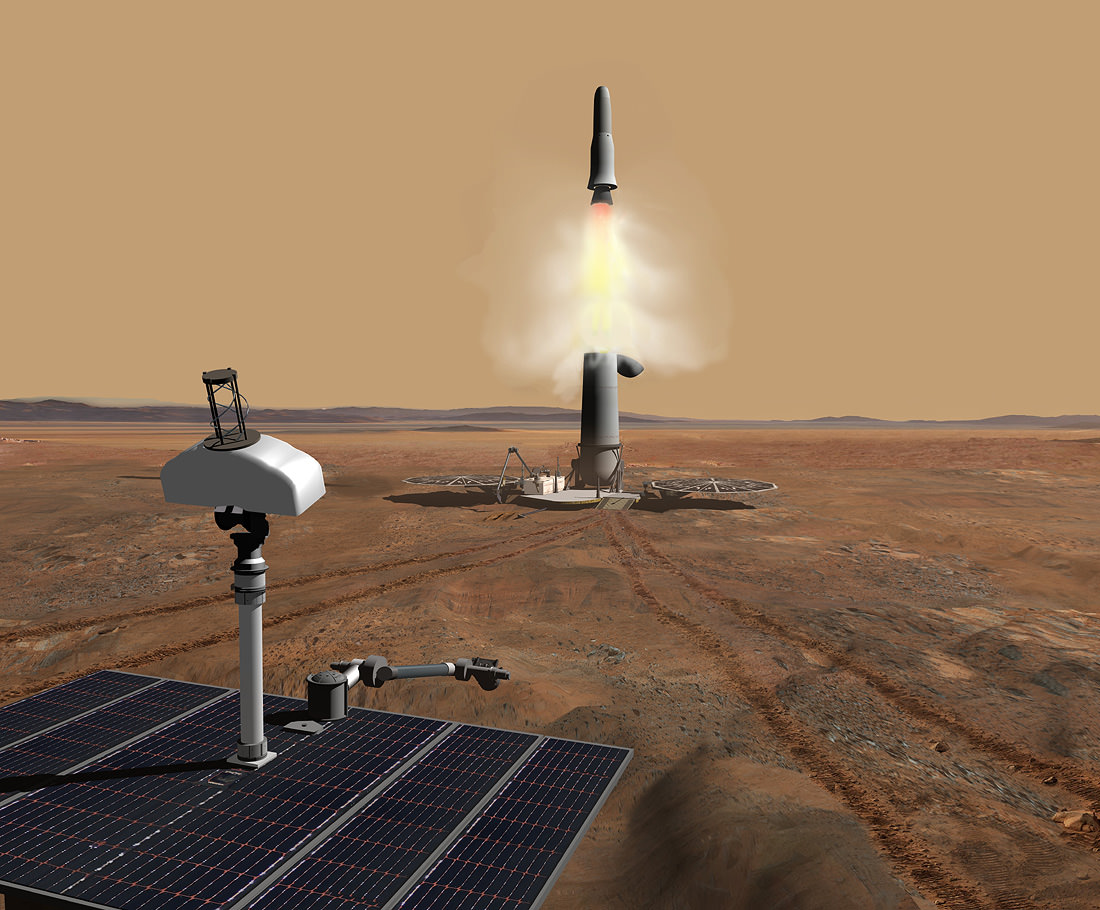It’s easy to forget that, despite life having existed on Earth for billions of years and despite our relatively carefree existence from total destruction, throughout history there have been events that wiped out nearly everything! Fortunately for many life forms, they have the ability to go dormant and enter a state of reversible, reduced metabolic activity. In this state they are protected from decay and can survive long harsh periods where life would otherwise not survive. Is it just possible therefore that dormancy could also allow life to survive on other worlds like Mars or Venus?
Scientists Want to Use the Moon to Safeguard Earth’s Biodiversity

There’s something wrong with us.
We’ve risen to prominence on a world that’s positively “rippling with life,” as Carl Sagan described it. The more we study our planet, the more we find life eking out an existence in the most unlikely of places.
Yet we seem destined to drive many species to extinction, even though we see those extinctions coming from miles away.
As an indication of how serious the problem is, one group of researchers suggests we use the Moon—yes, the Moon—as a safe repository for Earth’s biodiversity.
Continue reading “Scientists Want to Use the Moon to Safeguard Earth’s Biodiversity”Even Tiny Amounts of DNA on Mars Will Be Detectable

The Search for Life is focused on the search for biosignatures. Planetary life leaves a chemical fingerprint on a planet’s atmosphere, and scientists are trying to work out which chemicals in what combinations and amounts are a surefire indicator of life. Martian methane is one they’re puzzling over right now.
But new evidence suggests that super-tiny amounts of DNA can be detected in Martian rocks if it’s there. And though it requires physical samples rather than remote sensing, it’s still an intriguing development.
Continue reading “Even Tiny Amounts of DNA on Mars Will Be Detectable”Life Could be Common Across the Universe, Just Not in Our Region
The building blocks of life can, and did, spontaneously assemble under the right conditions. That’s called spontaneous generation, or abiogenesis. Of course, many of the details remain hidden to us, and we just don’t know exactly how it all happened. Or how frequently it could happen.
Continue reading “Life Could be Common Across the Universe, Just Not in Our Region”Nutrient-Poor and Energy-Starved. How Life Might Survive at the Extremes in the Solar System
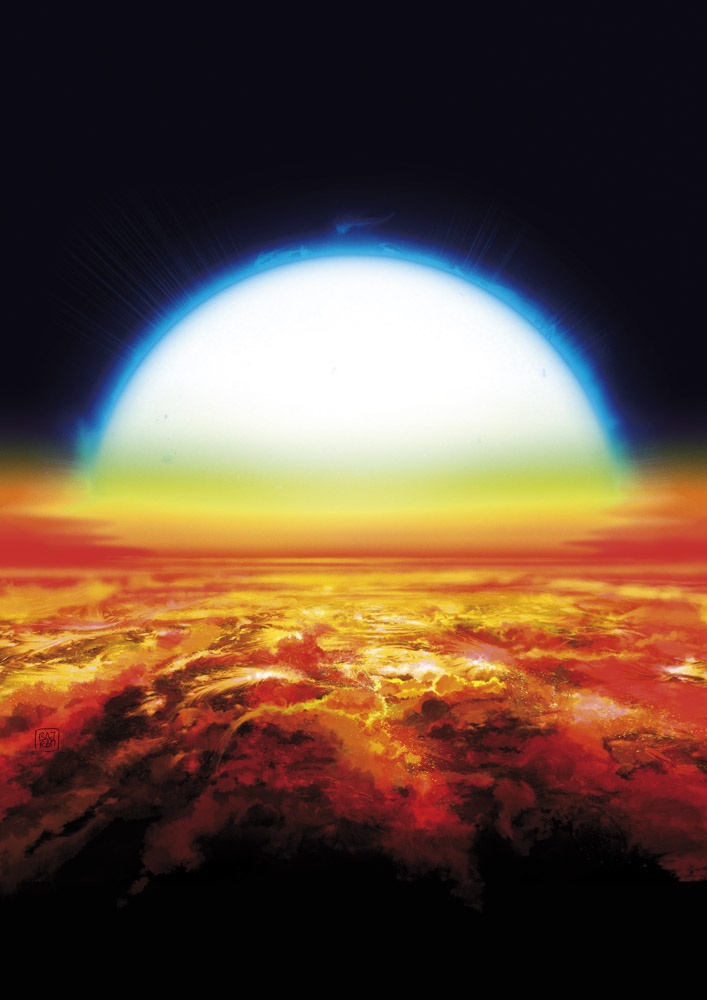
Our growing understanding of extremophiles here on Earth has opened up new possibilities in astrobiology. Scientists are taking another look at resource-poor worlds that appeared like they could never support life. One team of researchers is studying a nutrient-poor region of Mexico to try to understand how organisms thrive in challenging environments.
Continue reading “Nutrient-Poor and Energy-Starved. How Life Might Survive at the Extremes in the Solar System”Microsoft and Partners Hope to Create a Time Capsule… On the Moon!
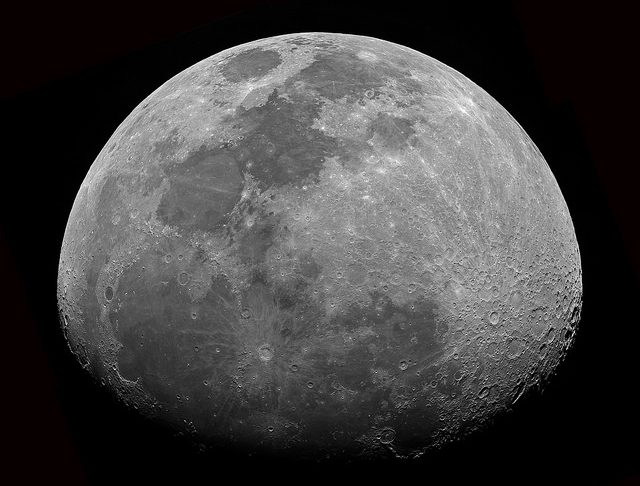
Time capsules are a fun and time-honored way to preserve pieces of the past. In most cases, they include photographs, mementos and other items of personal value, things that give future generations a sense of what life was like in the past. But what if we intend to preserve the memories and experiences of an entire species for thousands of years? What would we choose to squirrel away then, and where would be place it?
That’s precisely what researchers from the Molecular Information Systems Lab at the University of Washington (UW) and Microsoft had in mind when they announced their #MemoriesInDNA project. This project invites people to submit photos that will be encoded in DNA and stored for millennia. And thanks to a new partnership with the Arch Mission Foundation, this capsule will be sent to the Moon in 2020!
Continue reading “Microsoft and Partners Hope to Create a Time Capsule… On the Moon!”
What’s that Strange Glowing Mold? Astronauts will Soon be Able to Sequence Unknown Space Organisms
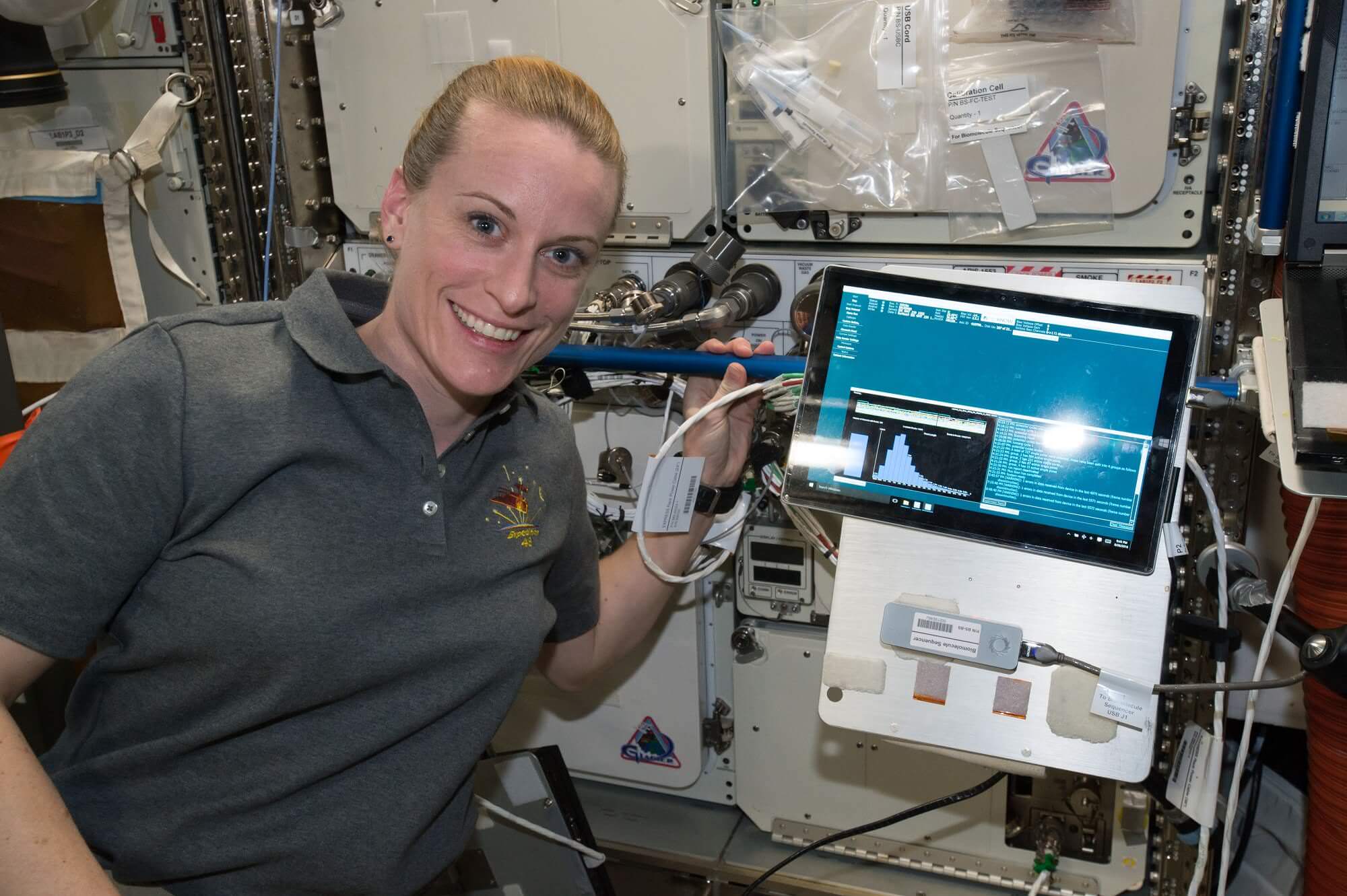
Seeking to understand more about space-born microbes, NASA has initiated a program known as Genes in Space-3 – a collaborative effort that will prepare, sequence and identify unknown organisms, entirely from space. For those who might be thinking that this sounds a lot like the film Life – where astronauts revive an alien organism on the International Space Station and everyone dies! – rest assured, this is not the setup for some horror movie.
In truth, it represents a game-changing development that builds on recent accomplishments, where DNA was first synthesized by NASA astronaut Kate Rubin aboard the International Space Station in 2016. Looking ahead, the Genes in Space-3 program will allow astronauts aboard the ISS to collect samples of microbes and study them in-house, rather than having to send them back to Earth for analysis.
The previous experiments performed by Rubin – which were part of the Biomolecule Sequencer investigation – sought to demonstrate that DNA sequencing is feasible in an orbiting spacecraft. The Genes in Space-3 seeks to build on that by establishing a DNA sample-preparation process that would allow ISS crews to identify microbes, monitor crew health, and assist in the search for DNA-based life elsewhere in the Solar System.
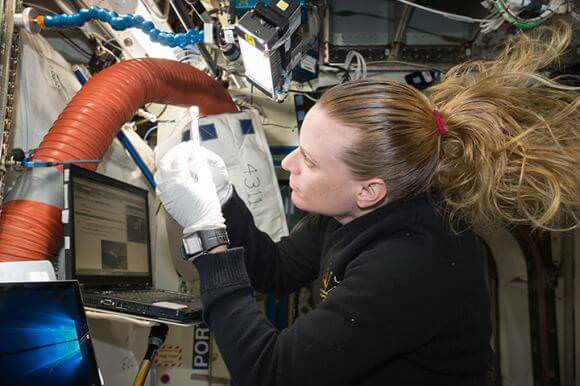
As Sarah Wallace – a NASA microbiologist and the project’s Principal Investigator (PI) at the Johnson Space Center – said in a recent press release:
“We have had contamination in parts of the station where fungi was seen growing or biomaterial has been pulled out of a clogged waterline, but we have no idea what it is until the sample gets back down to the lab. On the ISS, we can regularly resupply disinfectants, but as we move beyond low-Earth orbit where the ability for resupply is less frequent, knowing what to disinfect or not becomes very important.”
Developed in partnership by NASA’s Johnson Space Center and Boeing (and sponsored by the ISS National Lab), this project brings together two previously spaceflight-tested molecular biology tools. First, there is miniPCR, a device which copies targeted pieces of DNA in a process known as Polymerase Chain Reaction (PCR) to create thousands of copies.
This device was developed as part of the student-designed Genes in Space competition, and was successfully tested aboard the ISS during the Genes in Space-1 experiment. Running from September to March of 2016, this experiment sought to test if the alterations to DNA and the weakening of the immune system (both of which happen during spaceflight) are in fact linked.
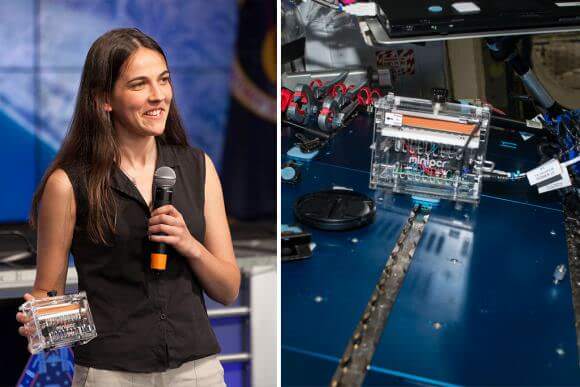
This test will be followed-up this summer with Genes in Space-2 experiment. Running from April to September, this experiment will measure how spaceflight affects telomeres – the protective caps on our chromosomes that are associated with cardiovascular disease and cancers.
The MinION, meanwhile, is a handheld device developed by Oxford Nanopore Technologies. Capable of analyzing DNA and RNA sequences, this technology allows for rapid analysis that is also portable and scalable. It has already been used here on Earth, and was successfully tested aboard the ISS as part of the Biomolecule Sequencer investigation earlier this year.
Combined with some additional enzymes to demonstrate DNA amplification, the Genes in Space-3 experiment will allow astronauts to bring the lab to the microorganisms, rather than the reverse. This will consist of crew members collecting samples from within the space station and then culturing them aboard the orbiting laboratory. The samples will then be prepared for sequencing using the miniPCR and sequenced and identified using the MinION.
As Sarah Stahl, a microbiologist and project scientist, explained, this will allow crews to combat the spread of infectious diseases and bacteria. “The ISS is very clean,” she said. “We find a lot of human-associated microorganisms – a lot of common bacteria such as Staphylococcus and Bacillus and different types of familiar fungi like Aspergillus and Penicillium.”
In addition to being able to diagnose illnesses and infections in real-time, the experiment will allow for new and exciting research aboard the ISS. This could include identifying DNA-based life on other planets, the samples of which would be returned to the ISS via probe. In addition, if and hen microbes are found floating around in space, they could be returned to the ISS for swift analysis.
Another benefit of the program will come from Earth-based scientists being able to access the experiments going on aboard the ISS in real-time. And scientists here on Earth will also benefit from the tools being employed, which will allow for cheap and effective ways to diagnose viruses, especially in parts of the world where access to a laboratory is not possible.
Once more, the development of systems and tools for use in space – an environment that is not typically conducive to Earth-based technologies – is offering up applications that go far beyond space travel. And in the coming years, ISS-based genetic research could help in the ongoing search for extra-terrestrial life, as well as provide new insights into theories like panspermia (i.e. the cosmos being seeded with life by comets, asteroids and planetoids).
Be sure to enjoy this video titled “Cosmic Carpool”, courtesy of NASA’s Johnson Space Center:
Further Reading: NASA
DNA Won’t Be Killed Dead By A Rocket Ride To Space, Study Suggests
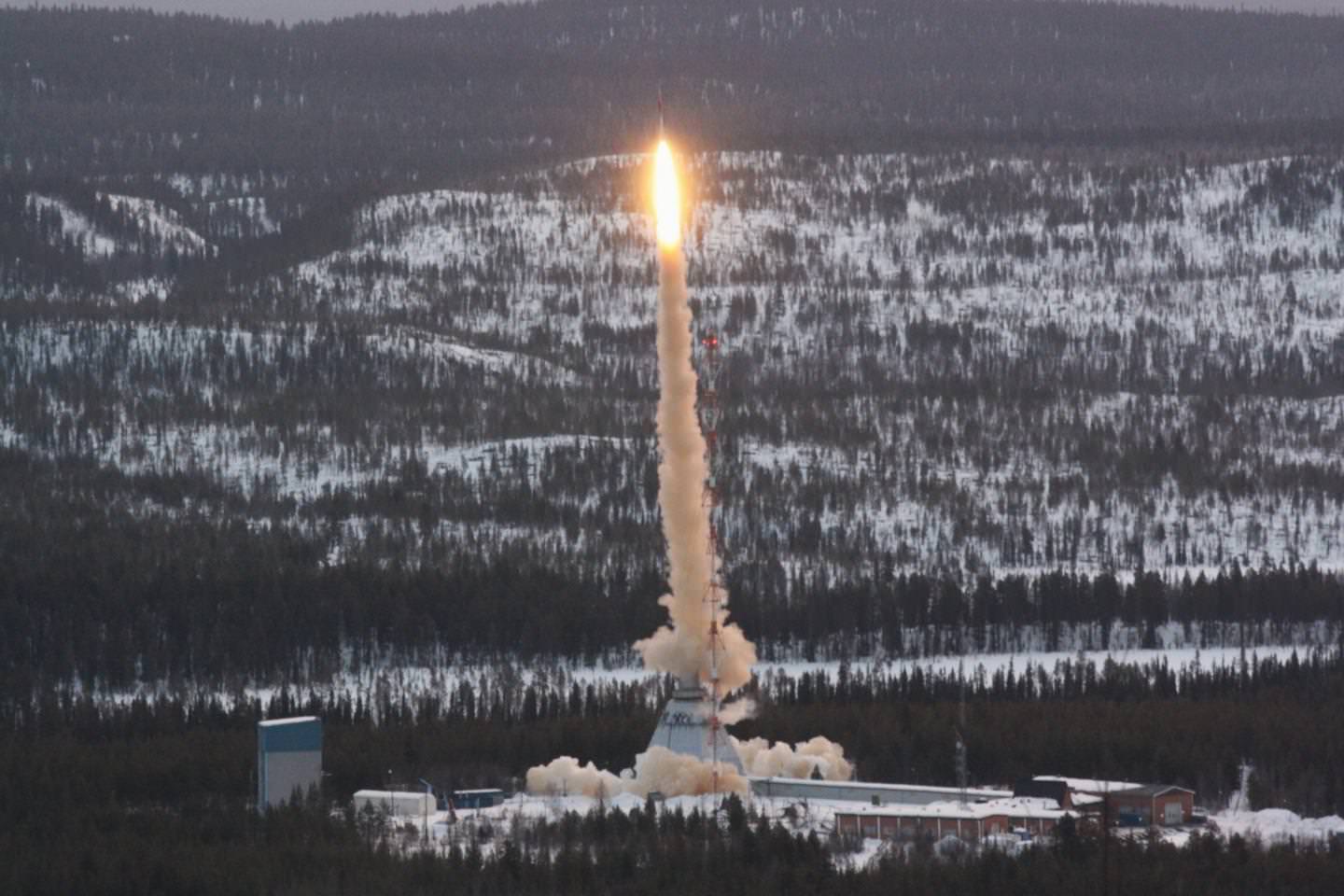
So how ’bout those planetary protection agreements? Turns out that plasmid DNA — the kind that exists in bacterial cells — may be able to survive a rocket trip to space, based on research with an engineered version. And if life’s building blocks can get there, perhaps they can even go beyond. The International Space Station? Mars?
This information comes from a single peer-reviewed study based on a sounding rocket that went into suborbital space in March 2011. Called TEXUS-49, its payload included artificial plasmid DNA that had both a fluorescent marker and an antibiotic resistance gene.
Even in the 13-minute flight, temperatures on the rocket exterior soared to 1,000 degrees Celsius (1,832 degrees Fahrenheit.) And remarkably, the DNA survived.
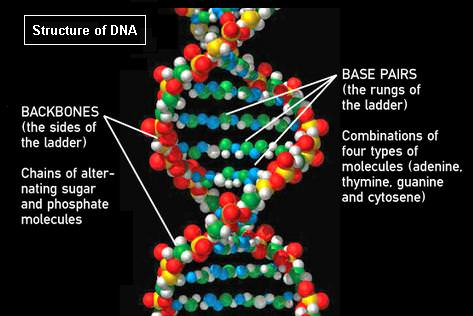
Not all of the DNA was working properly, though. Up to 35% of it had its “full biological function”, researchers stated, specifically in terms of helping bacteria with antibiotic resistance and encouraging the fluorescent marker to express itself in eukaryotic cells, the cell type found in animals and plants.
The next step, naturally, would be to test this theory with more flights, the authors suggest. But interestingly enough, DNA survival wasn’t even the intended goal of the original study, even though there are stories of simple life surviving for a time in space, such as spores on the exterior of the International Space Station shown in the image below.
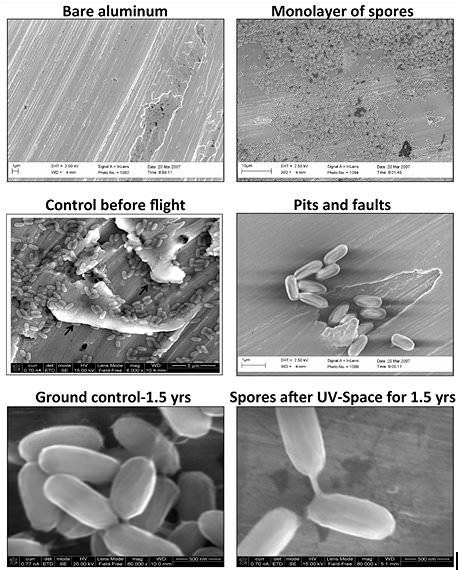
“We were totally surprised. Originally, we designed this experiment as a technology test for biomarker stability during spaceflight and re-entry,” the authors wrote in a statement for PLOS.
“We never expected to recover so many intact and functional active DNA. But it is not only an issue from space to Earth, it is also an issue from Earth to space and to other planets: Our findings made us a little bit worried about the probability of contaminating spacecrafts, landers and landing sites with DNA from Earth.”
You can read more about the study in the journal PLOS One. The research was led by the University of Zurich’s Cora Thiel.
Source: PLOS
Catastrophic Impacts Made Life on Earth Possible
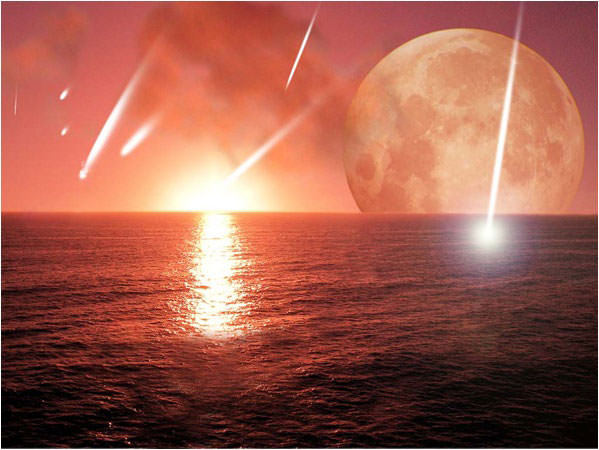
How did life on Earth originally develop from random organic compounds into living, evolving cells? It may have relied on impacts by enormous meteorites and comets — the same sort of catastrophic events that helped bring an end to the dinosaurs’ reign 65 million years ago. In fact, ancient impact craters might be precisely where life was able to develop on an otherwise hostile primordial Earth.
This is the hypothesis proposed by Sankar Chaterjee, Horn Professor of Geosciences and the curator of paleontology at the Museum of Texas Tech University.
“This is bigger than finding any dinosaur. This is what we’ve all searched for – the Holy Grail of science,” Chatterjee said.
Our planet wasn’t always the life-friendly “blue marble” that we know and love today. At one point early in its history it was anything but hospitable to life as we know it.
“When the Earth formed some 4.5 billion years ago, it was a sterile planet inhospitable to living organisms,” Chatterjee said. “It was a seething cauldron of erupting volcanoes, raining meteors and hot, noxious gasses. One billion years later, it was a placid, watery planet teeming with microbial life – the ancestors to all living things.”
Exactly how did this transition happen? That’s the Big Question in paleontology, and Chatterjee believes he may have found the answer lying within some of the world’s oldest and largest impact craters.
After studying the environments of the oldest known fossil-containing rocks in Greenland, Australia and South Africa, Chatterjee said these could be remnants of ancient craters and may be the very spots where life began in deep, dark and hot environments — similar to what’s found near thermal vents in today’s oceans.
Larger meteorites that created impact basins of about 350 miles in diameter inadvertently became the perfect crucibles, according to Chatterjee. These meteorites also punched through the Earth’s crust, creating volcanically driven geothermal vents. They also brought the basic building blocks of life that could be concentrated and polymerized in the crater basins.
In addition to new organic compounds — and, in the case of comets, considerable amounts of water — impacting bodies may also have brought the necessary lipids needed to help protect RNA and allow it to develop further.
“RNA molecules are very unstable. In vent environments, they would decompose quickly. Some catalysts, such as simple proteins, were necessary for primitive RNA to replicate and metabolize,” Chatterjee said. “Meteorites brought this fatty lipid material to early Earth.”
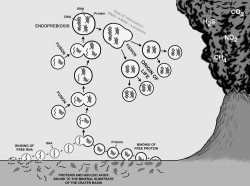
Based on research in Australia by University of California professor David Deamer, the ingredients for all-important cell membranes were delivered to Earth via meteorites and existed in water-filled craters.
“This fatty lipid material floated on top of the water surface of crater basins but moved to the bottom by convection currents,” suggests Chatterjee. “At some point in this process during the course of millions of years, this fatty membrane could have encapsulated simple RNA and proteins together like a soap bubble. The RNA and protein molecules begin interacting and communicating. Eventually RNA gave way to DNA – a much more stable compound – and with the development of the genetic code, the first cells divided.”
And the rest, as they say, is history. (Well, biology really, and no small amount of chemistry and paleontology… and some astrophysics… well you get the idea.)
Chatterjee recognizes that further experiments will be needed to help support or refute this hypothesis. He will present his findings Oct. 30 during the 125th Anniversary Annual Meeting of the Geological Society of America in Denver, Colorado.
Source: Texas Tech news article by John Davis
Mars Sample Return Mission? Naaah… Just Beam Back Martian DNA
Artist concept of a Mars Sample Return mission. Credit: Wickman Spacecraft & Propulsion.
A Mars sample return mission has long been a dream and goal of many planetary scientists. Getting Martian soil samples back here on Earth would allow them to be studied in ways rovers and landers just can’t do. Of course, the big reason for getting samples of Mars back to Earth would be to really determine if there ever was – or is — life on Mars. But a sample return mission would be “hellishly difficult,” Steve Squyres of the MER mission once said.
But forget sending a lander, scooping up samples, putting them in a capsule and somehow rocketing them back to Earth. Human genome sequencer Craig Venter wants to send a DNA sequencing machine Mars, and beam back the DNA data to Earth. Not to be outdone, Jonathan Rothberg, founder the DNA sequencing company Ion Torrent, is working on getting his Personal Genome Machine to Mars and sending back the data.
In articles in the Los Angeles Times and MIT’s Technology Review this week the two biologists seem to be in a race, of sorts, to see who could send their DNA machines to Mars first. Venter was quoted as saying, “There will be life forms there,” Venter said, and wants to build a “biological teleporter.”
Rothberg is looking to be part of a NASA-funded project at Harvard and MIT called SET-G, or “the search for extraterrestrial genomes.”
An MIT researcher involved in the project, Christopher Carr, told Technology Review that his lab is working to shrink Ion Torrent’s machine from 30 kilograms down to just three kilograms so that it can fit on a NASA rover, and they are testing how well the device can withstand the heavy radiation it would encounter on the way to Mars.
With NASA’s current budget woes, a sample return mission likely couldn’t happen until around 2030. But another Mars rover mission may be slated for 2018, if all goes well, and a DNA sequencer could potentially be part of the mission, the two biologists said. And an in-situ DNA sequencer avoids the potential pitfalls of a sample return mission.
“People are worried about the Andromeda strain,” Venter said. “We can rebuild the Martians in a P-4 spacesuit lab instead of having them land in the ocean.”
Sources: Los Angeles Times, Technology Review



